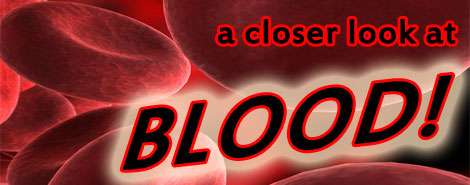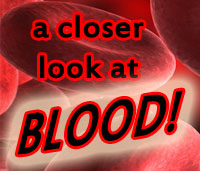Introduction to Live Blood (reprinted below from our
blog) | Our Services

There are four parts to blood: red blood cells, white
blood cells, platelets, and plasma. Using a specialized
microscope, one can easily view these parts of the
blood. Red blood cells deliver oxygen to, and carbon
dioxide from, the body. White blood cells, also known as
leukocytes, help defend the body against disease and
anything that they see as unnatural or foreign.
Platelets help form clots to prevent bleeding. Plasma,
comprised of about 90% water, is the fluid that
transports all of the above.
 You
can learn a lot about a person�s overall health by
viewing his or her blood. In broad, general terms, what
you�re looking for in viewing live blood is the overall
shape of the cells (particularly the red blood cells),
the percentage of white blood cells to red blood cells,
how �fluid� the sample is, and any debris present.
You
can learn a lot about a person�s overall health by
viewing his or her blood. In broad, general terms, what
you�re looking for in viewing live blood is the overall
shape of the cells (particularly the red blood cells),
the percentage of white blood cells to red blood cells,
how �fluid� the sample is, and any debris present.
Again, when viewing blood, you�re basically looking for
an overall picture of health. Some individuals who view
live blood for a living believe that they are able to
determine what�s going on in your body, what illnesses
you have, what supplements you need, etc., based on what
they�re seeing. This, however, borders on fraudulent
practices. Yes, you can usually tell that the body is
fighting something when the amount of white blood cells
is increased. However, there is no way to determine
*what* the body is fighting (or if, in fact, there is a
disease causing leukocyte proliferation). You can also
easily see when the blood is filled with various red
blood cell shape deviations and/or cell deformities.
These in fact can indicate a general picture of
suboptimal health. However, one cannot determine the
underlying cause of cell deformities without further
testing.
In fairness, there are live blood practitioners who may
in fact mean well when they look at a specimen and
recommend trying a specific protocol to improve the
state of the person�s blood. But, unless they�re
communicating to the individual that they�re basing the
recommendation on a good bit of guesswork, then they may
be misleading that individual.
Many live blood practitioners believe that certain cell
deformities indicate specific health concerns (e.g., low
B vitamins, evidence of toxins in the system, presence
of candida/yeast, bacteria, etc.). While there is
potential for overall indication based on experience for
individuals with certain illnesses consistently display
identical types of cell deformities, it�s still
impossible to make an official diagnosis.
Some deformed red blood cells may look like squiggling
worms, jumping ants, bacteria, etc. But without an
understanding of the positive and negative charges of
the various components in the blood, one may determine
that these deformities are actually what they look like
(worms, bacteria, etc.). It�s too difficult to explain
the chemistry and science behind this at this time. But
we just want to let you know that, if you ever have your
blood viewed under a microscope, if it looks like there
are worms, little dots zipping all around, or other
strange behavior, don�t panic. It�s pretty common to see
some of this in most blood.
Visiting a live blood cell practitioner can certainly be
enlightening because you�ll be able to see an overall
picture of health and well being. Be warned, however,
that a practitioner who seems to be diagnosing and/or
pushing supplements may be misguided. We say misguided
because many practitioners have taken courses that
specifically teach them to interpret the various aspects
of the blood and then treat those things with specific
protocols. While sometimes the protocols may indeed by
helpful, it�s not an exact science.
There are, we�re sad to say, some fraudulent live blood
practitioners who purposely treat the blood sample in
ways in which to create an overall view of ill health,
when one may not actually exist. In our own studies and
experiments, we�ve seen how this can be possible.
Collecting too big or too little a sample, viewing a
sample only on the outer edge of the slide, or applying
too much pressure to the sample, for example, can easily
skew the results. A practitioner might also focus in on
things that aren�t even part of your blood � such as
bubbles or debris that was on the slide. (A slide might
look clean to the naked eye, but don�t forget that the
microscopes used are zooming in with incredible power!)
While that sounds awful, our take-home message is that
you shouldn�t discount the entire field of live blood
microscopy just because there are a few practitioners
simply trying to peddle supplements. We�re here to tell
you that live blood viewing IS in fact a fantastic tool
for viewing one�s overall health. From all of the blood
we�ve viewed so far, the blood of raw foodies shows an
overall healthier picture than those living on a
Standard American Diet. Just another reason to eat more
natural foods, eh?
Our Live Blood Services
Pure Jeevan is equipped with a full set-up for live
blood viewing and educational services. We purposely do
NOT refer to this as "live blood analysis," as we do not
offer analyses or diagnoses of your blood. However, if
you want to take a look at your blood, and talk about
what you see (identifying various types of cells and so
forth), we're happy to help. At the moment, we are based
in Pittsburgh, PA (soon relocating to Portland, OR). You
may inquire about an appointment to view your blood by
emailing Wendi at WendiDee [at] PureJeevan.com. The cost
is $65.








 You
can learn a lot about a person�s overall health by
viewing his or her blood. In broad, general terms, what
you�re looking for in viewing live blood is the overall
shape of the cells (particularly the red blood cells),
the percentage of white blood cells to red blood cells,
how �fluid� the sample is, and any debris present.
You
can learn a lot about a person�s overall health by
viewing his or her blood. In broad, general terms, what
you�re looking for in viewing live blood is the overall
shape of the cells (particularly the red blood cells),
the percentage of white blood cells to red blood cells,
how �fluid� the sample is, and any debris present.






